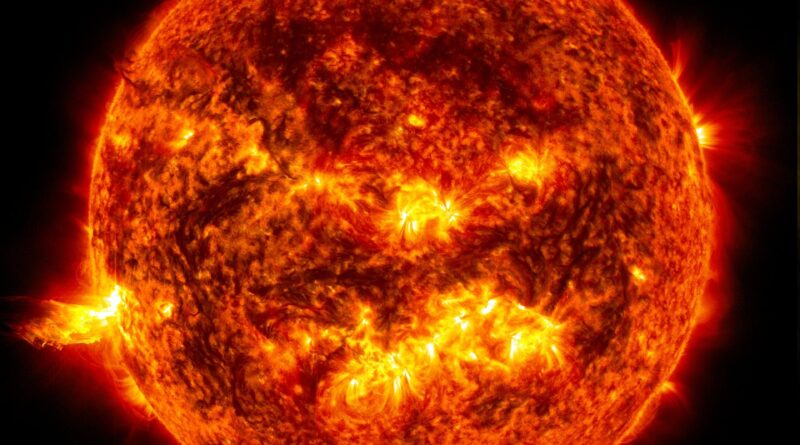The Sun: 8 Shocking Facts That Show Its True Power
The Sun is more than just the bright ball of light we see every morning. It is the heart of our solar system, providing energy for life, shaping our climate, and even influencing our technology. Though it feels familiar, the Sun is a 4.5-billion-year-old powerhouse full of mysteries and cosmic drama. In this blog, we’ll explore the Sun’s structure, importance, life cycle, and cultural impact—all in simple language, so you can truly appreciate the star that makes life possible on Earth.
1. What Exactly is the Sun?
The Sun is a yellow dwarf star (G2V) located at the center of our solar system. It’s not solid—it’s a massive glowing sphere of hydrogen (91%) and helium (8%) gas with a small mix of heavier elements like oxygen and carbon.
📌 Quick Facts about the Sun:
- Diameter: 1.4 million km (109 times Earth’s width)
- Mass: 99.86% of the entire solar system
- Core Temperature: 15 million °C
- Surface Temperature: 5,500 °C
- Speed around the Milky Way: 720,000 km/h
To put it simply: the Sun is so big it could fit 1.3 million Earths inside it!
2. The Sun’s Inner Layers: A Natural Power Plant
The Sun works like a giant nuclear reactor. Here’s how its layers function:
- Core: The hottest part, where nuclear fusion happens. Hydrogen atoms fuse into helium, releasing enormous energy. The Sun fuses 600 million tons of hydrogen every second!
- Radiative Zone: Energy here moves slowly. A single photon of light can take 170,000 years to escape this layer.
- Convection Zone: Hot plasma rises and falls like boiling water, carrying energy outward.
This energy finally reaches the photosphere (the “surface” we see) and travels to Earth in just 8 minutes as sunlight.
3. The Sun’s Atmosphere: Layers We Can See
The Sun’s atmosphere has three major parts:
- Photosphere – The visible “surface” where sunspots and solar flares occur.
- Chromosphere – A reddish glow seen during solar eclipses.
- Corona – The outer layer, extending millions of kilometers into space, hotter than the surface (up to 2 million °C). This is where the solar wind originates.
👉 Mystery: Scientists are still puzzled by why the corona is hotter than the Sun’s surface—a problem called the “Coronal Heating Problem.” Some believe it’s due to tiny magnetic explosions called nanoflares, or powerful magnetic waves transporting energy.
4. Space Weather: How the Sun Affects Earth
The Sun is not always calm—it goes through an 11-year cycle of activity. During solar maximum, the Sun produces more sunspots, solar flares, and coronal mass ejections (CMEs).
- Sunspots: Cooler, dark regions caused by magnetic fields.
- Solar Flares: Explosions of energy releasing radiation.
- CMEs: Huge blasts of plasma that can disrupt satellites, GPS, and power grids on Earth.
💡 Example: In 1859, the Carrington Event (a massive solar storm) disrupted telegraphs worldwide. If such an event happened today, it could cause trillions of dollars in damage to power systems and satellites.
5. The Life Cycle of the Sun
Like all stars, the Sun has a life story:
- Birth: Formed 4.5 billion years ago from a nebula (a cloud of gas and dust).
- Main Sequence: Its current stable phase, burning hydrogen (will last ~5 billion more years).
- Red Giant: In the far future, the Sun will expand so much it may swallow Mercury and Venus (and maybe Earth).
- White Dwarf: After shedding its outer layers, the core will shrink to a dense, Earth-sized star.
- Black Dwarf: Eventually, it will cool and fade away over trillions of years.
So, while the Sun feels eternal, it too has an expiration date.
6. The Sun in Human Culture
Since ancient times, people have worshipped the Sun as a god:
- Egyptians: Worshipped Ra, the Sun god.
- Aztecs & Mayans: Built calendars based on solar cycles.
- Greeks: Saw Helios driving a fiery chariot across the sky.
- Hindus: Still honor Surya, the Sun deity, in rituals.
Even today, monuments like Stonehenge align with solar events, showing how important the Sun was for farming, calendars, and spirituality.
Conclusion
The Sun is not just a star—it is our cosmic anchor. It gives us light, warmth, seasons, and energy. It drives Earth’s climate, powers life, and even challenges our technology through solar storms. At the same time, it inspires culture, mythology, and science.
By studying the Sun, we learn not only about our place in the universe but also about the future of Earth itself. From its fiery birth to its quiet end as a white dwarf, the Sun is both our protector and a reminder of the universe’s power.


Pingback: 7 Surprising Secrets of Mercury Planet You Need to Know
Pingback: Venus Planet: 10 Shocking Secrets and Space Missions Revealed
Pingback: Earth: 15 Incredible Facts About Our Pale Blue Dot - Astronomers